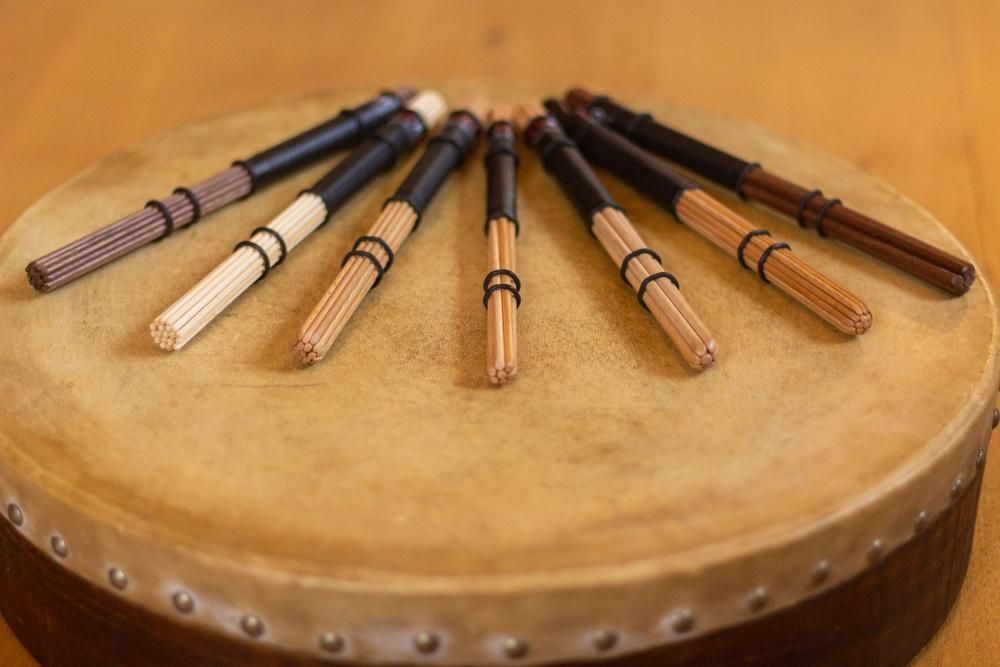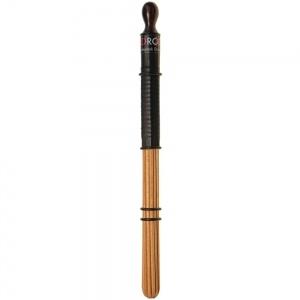Classic Hotrods


Classic Hotrods
Hotrod tippers, i.e. tippers composed of several sticks, are among the most popular tippers of all because they produce a very powerful and rounded sound.
This type of drumstick has been used in drumming for several decades and was transferred to the bodhrán early on by various players.
We have two types of hotrods: Classic Hotrods, which consist only of rods made of different woods, and Hybid Hotrods, which consist of a wooden handle and rods made of different woods.
We offer a wide range of different hotrod models, here is an overview and details of the classic hotrods:
The Concept
Starting from scratch, we have questioned and optimised every single detail of construction.
We have emerged with a variety of tippers that provide the player with different sound variations but have the same structure.
Therefore, all HedRods have a similar feel, and the changing from one to another requires less effort yet achieves a totally different sound.
It is importantly a product which is suitable for all common playing styles and grips without limitations.


Precision Control
In order to facilitate every playing/grip style, we wanted to create a grip which offers controlled handling without limiting the player to a certain playing technique, no matter if it is held in the middle, at 2/3 of its length or close to the end.
We achieved this with the Precision Control Grip: This consists of a thin net under aspecial shrink tube which provides comfortable support, it is unobtrusive and nonrestrictive.
Two adjustable rubber rings on the handle can be positioned individually to serve either as a quick positioning of the handle point, or as a grip area boundary.
The position and length of the grip area is deliberate and was found in terms of playability, sound and comfort as "just right".
The Rings
Compared to other hotrods, the HedRods have an additional rubber ring. This provides much more flexibility in the adjustment of the handling and has direct influence on the sound.
A Hotrod always feels a little "softer" than a tipper made of solid wood. This property can be changed in asurprisingly large range:
The front ring: this is used to set the "click behaviour" of the rods, the farther forward it sits, the less the rods move during impact, the typical clicking noise decreases. Of course it then follows that the click sound increases the further you move the ring towards the handle, because the rods have more freedom to move. Depending on the design of the rods, a sound similar to that produced by jazz brushes can be achieved.
The two rear rings: You can determine how solid the Hedrod feels by adjusting these. For example, if the front ring is at the very end of the HedRod and the two rear rings close to the handle, a very clear attack close to that of a solid tipper will be the result, however, it will still have the softer feel of a hodrod.
The reason for this is that the rods can move considerably between the foremost O-ring and the top of the handle - this causes energy to be dampened and you will feel a less attacking response. At the same time, less ‘unsprung mass’ hits the drum head and a lower bass volume is the result. In short, you can now adjust the movement by moving the rings.


The Details
Because only the attack sound, rather than the typical hotrod sound is heard when playing double ended triplets with the upper end of the tipper, we decided that the HedRod should be unidirectional. Therefore the upper end of the tipper is solidly constructed regarding to the attack sound.
Of course, this area is also glued so that the rods can never slip or change position.
The basic materials we use for all models are top quality, hand selected wooden rods (beech/walnut/bamboo) in different diameters and in top quality.
The surface of each stick is individually oiled and waxed. Each stick is individually surface-finished. The bamboo sticks are left natural.
The arrangement of the rods depends on the model and is either parallel to the axis of the tipper or slightly twisted in order to achieve a different click behaviour.
HR refers to Hedrod, the subsequent digit refers to the diameter of the rods in millimetres and and the final designation refers to the shape of the head, a critical detail to the desired sound.
Bodhrod - Cormac Byrne Signature Series
The Concept
Cormac describes his own Bodhrod design as “capable of producing those big warm bass notes but also those tight high pops in the top end.”
Collaborating with Stevie Moises, Cormac designed the Bodhrod to sit comfortably in the notch between the thumb and palm of your hand, with a non-slip grip. The tension ring can be easily adjusted to produce varying levels of click.
All Bodhrods feature a bundle of 12 x 3mm rods split into two bundles of 5 and 7 rods. Approx 23 cm long and 25 to 27 grams, depending on choice of wood: the lighter weight all maple (CB1), heavier all walnut (CB3), the new beech (CB4) or the Hybrid (CB2) comprised of 5 x walnut and 7 x maple rods.

BELLrod - Matthew Bell Signature Series

The Triangle
Matt Bell wanted a slightly longer hotrod when developing the BELLrods, so all BELLrods have a length of 26 cm.
In addition, the aim was to develop an optimal handle that, unlike the usual round hotrods, has a triangular cross-section. The triangular shape could be achieved by arranging the 12 dowels in a special way. This shape of the cross-section offers a different, improved grip feeling.
The firm grip is further enhanced by the stronger grating of the shrink tubing on the handle, which also provides more grip.
All in all, an exceptional design that fits very well in the hand and offers the typical Hotrod sound.















